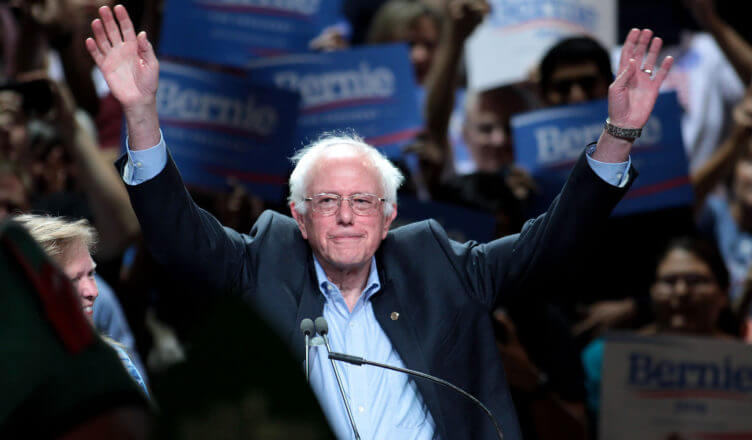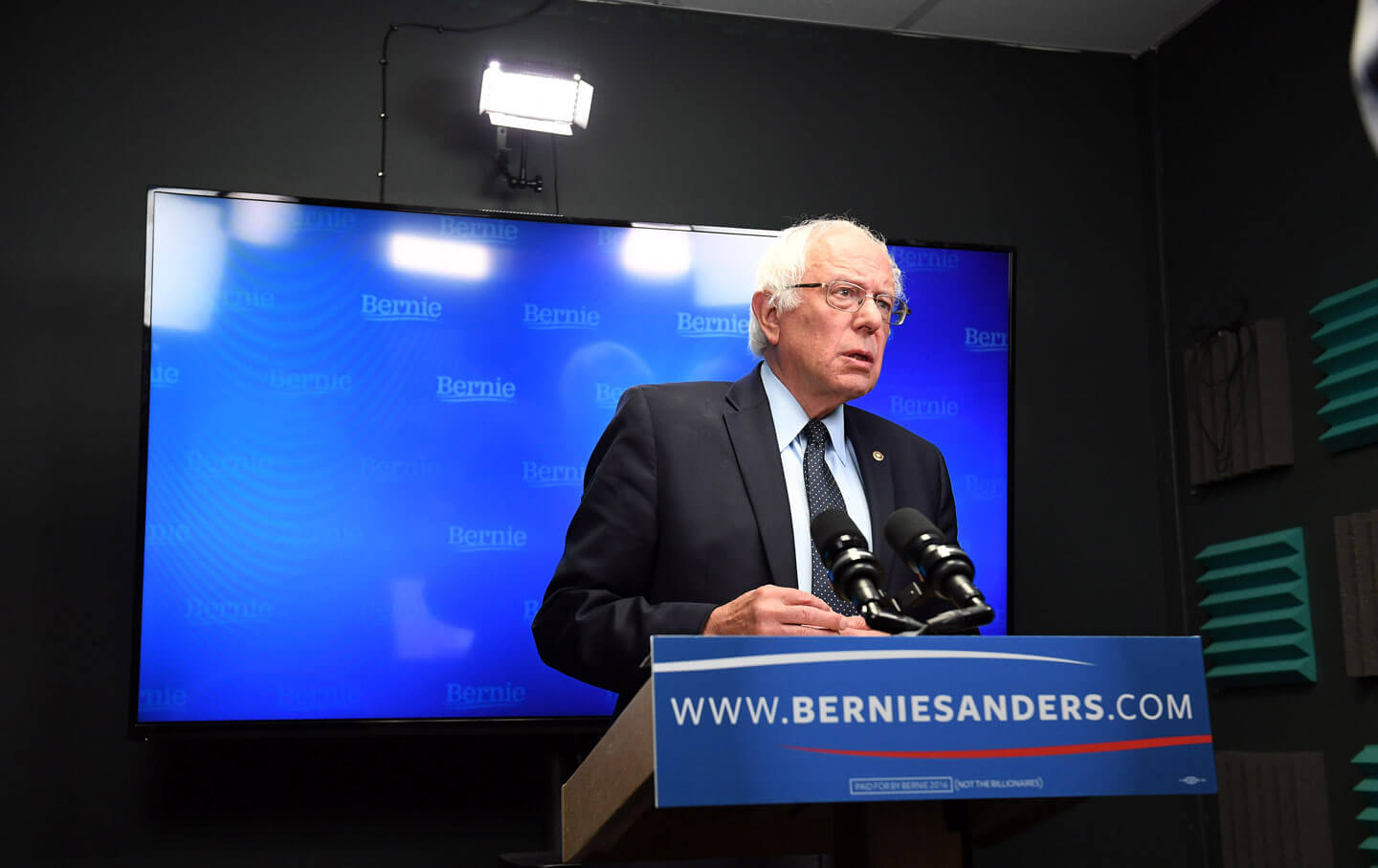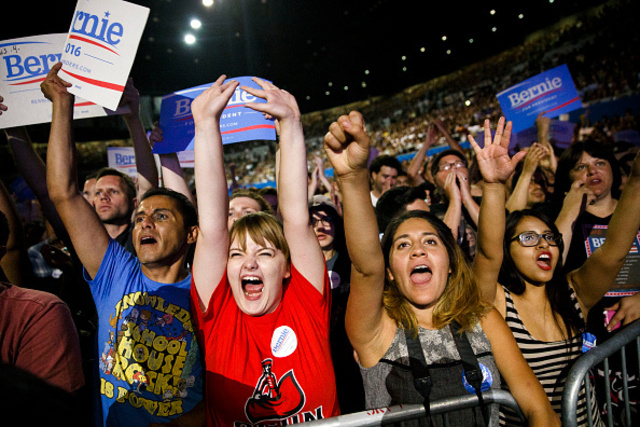Only Socialism Can Defeat Trumpism
Millions of ordinary people are ready for an alternative, one pointed to by the success of Bernie Sanders.
By Nicole Aschoff and Bhaskar Sunkara
Ιt’s Wednesday, November 9, and Hillary Clinton has defeated Donald Trump. Media commentators and political observers are celebrating the triumph of rationality, but a nagging question looms: In the battle between Clinton and Trump, who would have won if Trump had followed the wisdom of his staff and reined himself in a bit rather than stumbling into a million gaffes?
The likelihood of this post-election scenario is a reminder that even if Clinton can defeat Trump in November, Clintonism is ill-equipped to beat back Trumpism in the long run. It will take a much more radical vision to channel the popular anger that Trump has exposed toward positive ends.
Sure, the Democratic platform is its most progressive in years. Adopting the demands of Bernie Sanders supporters for a $15 minimum wage, affordable public-university tuition, new financial regulations, and a softened Trans-Pacific Partnership were enough to placate the Vermont senator and many of his followers. But the party remains firmly oriented toward business, defined by a decades-long record that includes NAFTA, gutting welfare, handouts to Wall Street, and the championing of projects like the Keystone XL pipeline. Disillusioned progressives could certainly be forgiven for doubting the party will keep its promises after the election.
Moreover, a significant number of Americans, who feel alienated from the political and economic establishment now aligned behind Clinton, remain firmly in Trump’s camp. So while it seems increasingly likely that a majority of voters will ultimately balk at Trump’s xenophobia and fearmongering, Democrats will have to deal with the rhetoric of Trumpism for cycles to come, especially in state and local races. Mainstream Republicans may spurn Trump, but they share much in common with their candidate and have total or split control of 34 state legislatures. Under President Obama, Democrats have lost almost a thousand state-legislature seats, a dozen gubernatorial races, 69 House seats and 13 in the Senate. A Clinton victory, even a sizable one, will not turn back this tide.
And it’s naive to suggest—as many Democrats have—that this political shift is simply the result of massive investment of money in politics by the Koch brothers and their ilk, and would melt away in the event of strong campaign finance reform or through reversing the GOP’s radical 2010 redistricting effort. Many Republican campaigns are rooted in deep grassroots organizing and enthusiasm, and Trump has only added to this zeal. The far-right populism fueling his campaign—and the rise of far-right parties in Europe—is here to stay, whether it’s featured at the front of the Republican ticket in 2020 or not.
The Democratic Party must ponder a tough question: How much of Trump’s support among the white working class can really be chalked up to Republican propaganda and race-baiting, or is a good deal of populist anger rooted in the Democrats’ hypocrisy on economic issues? If the past eight years of Obama recovery haven’t benefited these workers, why would they be enthused to rally beyond his anointed successor?
After all, Trump can blithely talk about thumbing his nose at China, making NATO countries pay up, or tearing up the global trade architecture, but for the Democrats this kind of populism is a poor fit, even after the Sanders “revolution.” Such talk is fundamentally alien to the party’s pro-globalization, free-trade, belt-tightening identity of the past three decades. Heedless of its increasingly suffering base, Democratic leadership has persisted in staying the course and damping demands for more economic fairness.
The results of this rightward shift are stark. Poorly paid and precarious workers, the increasingly impoverished elderly, immigrants terrified by xenophobic rhetoric, and disillusioned millennials suffocating in debt are an ocean crashing against shrinking islands of wealth and opportunity.
But the past year has shown that millions of ordinary people are ready for an alternative, one pointed to by the success of Sanders and the Labour Party leader Jeremy Corbyn in Britain. These leaders have tried to articulate a humanist, social-democratic vision—a platform with concrete demands that, if met, would improve the lives of the poor, restore dignity and means to workers, and assure young people that their efforts are not in vain. This vision resonates with voters. This is the vision that must be built on—and expanded—by any party that wants to be relevant in these times.
Hillary Clinton and the Democratic Party would do well to take the popular demand for an alternative seriously. Americans—especially young adults and minorities—don’t see Sanders as a dinosaur trading on nostalgia or harking back to an irredeemable past. Instead, they see capitalism as a key source of their troubles. A recent Harvard University poll of Americans between the age of 18 and 29 found that 51 percent did not support capitalism, compared to only 42 percent who said they did. This doesn’t mean a socialist majority is right around the corner—only 33 percent offered it up as an alternative—but the poll indicates a significant shift in attitudes from just a few years ago.
Results like these fit within a broader picture of discontent. A majority of young Americans, including college-educated millennials, saddled with debt and dealing with bad jobs or no jobs, identify as working class—60 percent, more than any other group of Americans, suggesting that a class-based politics is increasingly salient. Even before Sanders ran for president, 66 percent of Americans saw “very strong” or “strong” conflicts between rich and poor, and recent data show that the wealth gap between middle-class Americans and elites has reached a record high. The vast majority of Americans are unhappy with the status quo, and most are willing to pay higher taxes or tax the rich for programs to improve public education and fund Social Security and Medicare.
Most Democratic politicians appear unwilling to acknowledge the extent of these shifts. But in this post-2008 climate, replete with anger against the establishment, the Clintonist approach of winning over moderates and drawing in reluctant leftists presupposes the existence of an ideological center that increasingly cannot hold. It might not be apparent on the eve of their November 8 triumph, but it will soon be.
As with the collapsing social democrats in Europe, the Democratic Party’s best bet is to move left and embrace a platform that speaks to the real needs, fears, and aspirations of working people. This doesn’t mean looking back with rose-colored glasses on the New Deal; it means building a coalition of young people, working-class whites, and minority voters around a new politics.
Those of us to the left of Clinton and the Democrats don’t have all the answers. But we have a good idea of where to start.
First, call for single-payer healthcare and free, quality public education—including higher education—for people of all ages. Fight for robust maternal and paternal leave and universal pre-K to help young families. These policies, despite debates on how to pay for them, are easily grasped and popular. The widespread support for Bernie’s broadsides against the “millionaire and billionaire” class shows that Americans are tired of handouts to Wall Street and the elite, and are ready for a new, progressive tax scheme to foot the bill.
But gains like single-payer and free higher education wouldn’t just be about giving a handout to working people instead of the rich. They would be part of a social movement demanding a decent life for all Americans. This movement would have a broader vision, one that includes the demand for a national job guarantee. Giving everyone a decent job isn’t a pipe dream. It’s a logical way to address pressing social problems and it’s achievable, through a robust expansion of public employment with an eye toward addressing social needs like infrastructure, education, and scientific research and scholarship in the public interest.
Policies like these will not only help alleviate material suffering, they will eventually help unite a divided electorate. Programs that benefit all Americans will foster the sense of solidarity and political engagement necessary to building a lasting progressive coalition in this country.
The alternative is more anxiety and inequality, a further decline in the Democratic Party’s base, and the continued growth of a Trump-like far right that is actively positioning itself to pick up the pieces. For the Democrats, no less than their peers in Europe, where the neoliberalization of social democracy has opened up space for a populist right, the choice on offer might well be either socialism or irrelevance.











